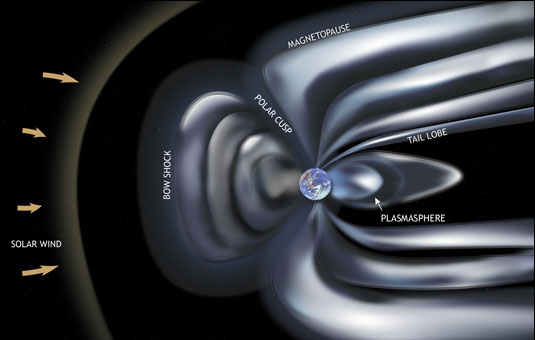
| Close-up
of a drawing that shows the different features
of the Magnetosphere. |
|
|
For thousands of years, mariners have used the Earth's magnetic field as a compass to find their way to safe harbor. The Earth's field looks very much like the magnetic field of a common bar magnet.
A Closed Circuit
Every square meter of the Earth is pierced by a line of magnetic force, which loops from deep inside the Earth, and far into space, only to return back in a great closed circuit thousands of kilometers away. If there were no Sun or solar wind, the Earth's magnetic field would extend far beyond the orbit of the moon and millions of kilometers into interplanetary space, in the same shape as a bar magnet field outlined by iron filings. In reality, the action of the solar wind changes this picture rather dramatically.
On the daytime side, the field is pushed in by the solar wind pressure, and on
the nighttime side, it is invisibly stretched out like a comet's tail. Scientists
call the region near the Earth where its field controls the motions of electrically
charged particles the magnetosphere. As the Earth rotates, and as the solar wind
and coronal mass ejections buffet it from the outside, the magnetosphere trembles
and can become stormy. When these rapid, though subtle, changes happen, compass
bearings can become unreliable by up to several degrees at the Earth's surface.
In space, even more dramatic changes can happen.
A Sun-Earth System
When the solar wind and the magnetosphere are taken together they operate like
a powerful, but invisible system. Depending on the magnetization of the particles
in the solar wind the field can be southward or northward attracting or repelling
the Earth's field. On the daytime side of the Earth, these fields connect together
and cause a transfer of particles and magnetic energy into the Earth's magnetosphere
from the solar wind. These changes in the Earth's particles and fields cause
severe magnetic storms which can be easily seen at ground level with sensitive
magnetic field detectors called magnetometers.
The magnetotail resembles a comet's tail and is stretched by the solar wind into
a vast cylinder of magnetism nearly one million kilometers long. Changes in the
solar wind and in the magnetosphere can also cause the magnetotail region to
change in complex ways.
Rubber Bands and Rings
Magnetic fields in the magnetotail can snap like rubber bands and reconnect themselves, and the particles tied to field will flow down these field lines and plunge deep into the interior of the magnetosphere cavity producing auroras.
Some of these particles can take up temporary residence in an equatorial zone called the ring current. In this vast, invisible river nearly 40,000 kilometers wide, positively-charged particles flow westwards and negatively-charged particles flow eastwards like two trains on opposite tracks. In fact, the flows are so dilute that they actually occupy the same space. Other particles from the magnetotail ride the field lines deep into the Earth's atmosphere carrying the currents which power the beautiful aurora.
Text adapted from the Sun-Earth Connection Tutorial courtesy
of NASA, originally written by
Dr. Sten Odenwald. Images and
videos courtesy of NASA unless otherwised noted.
Page 7 of 10 |
|
 |
|
 |
 |
Visit other pages in this section that focus on aspects of the Sun-Earth Connection.
|
|
 |
|
|




